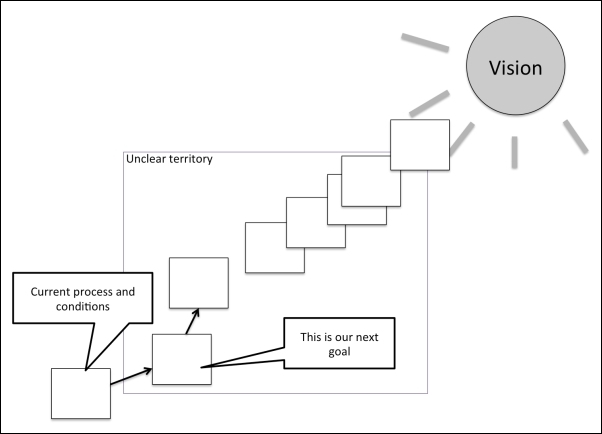Lean
Lean is a management philosophy developed at Toyota. The Kanban process with signal cards described at the beginning of the chapter is a part of Lean, but there are many other components to it as well. It is described in 14 principles, which tell us to think long-term and focus on quality and the smoothness of a process's flow. It is centered upon the understanding that cost originates from more things than machines and people. There are invisible costs that exist between people and machines. For Toyota, it is car parts that were waiting to be used. These parts not only required storage and transportation but also risked being damaged during transportation. There was also the chance that they would grow old in storage and at the end be thrown away because they were not needed anymore.
For software development, these in between costs can be found in pre-studies, design documents, and code that have not yet been released to the market. You have the cost but no value. Some of this will become valuable but some of it will be outdated before it generates any value. The Lean idea is to reduce the risk for outdated products by shortening the time to market or at least the time before you get feedback. You want to know if you are doing the right things or not and you want to take as little risk as possible.
Besides the 14 principles, Lean is a way of thinking and an attitude. It is about challenging problems, continuously improving and continuously striving for perfection. With a Lean attitude, we know that our competitors have the same problems that we have, and if we are a little better than the competitors dealing with the problems, then we are ahead of them in our competition.
When I (Tomas) was in Japan 2009 visiting Lean companies, something I repeatedly heard was "if we are not a little better next week than we are this week, we will sooner or later be out of business". When visiting European and American companies I do more often hear "we are the best". Lean companies are looking for perfection; they do not settle with just being the best for now.
In the Lean attitude, there is also a way of handling visions that are overwhelming. It is a simple way and can be described with these steps:
Define your vision even if it feels impossible to reach.
Define where you are now.
Define what next reachable goal in the right direction.
Iteratively make improvements until the goal is reached.
Steps 2 to 4 should be repeated forever, as long as the vision is still valid. If it is not, you will need to go back and find a way of redefining it.
This image shows the Lean attitude:

A Lean attitude is a way of taking small steps in the direction toward the vision
There is another way of looking at the way of taking small steps towards the vision. When you have employers who are very fond of Kanban, they might complain that you're not taking the big steps to the vision immediately. This thinking helps people understand that it's hard to take those big steps and that the vision might be easier to reach by taking small steps. The organization is then able to slowly, at its own pace, make changes. Those who are eager for big steps can feel calm knowing that the company is moving in the right direction.
Lean is also about ensuring that workers are encouraged and expected to continuously suggest and implement improvements in their way of working. To be able to contribute, everyone needs to get the full picture. That's why visualization is so important in Lean.
The 14 principles of Lean
Long-term philosophy:
Base your management decisions on a long-term philosophy, even at the expense of short-term financial goals
The right process will produce the right results:
Create continuous process flow to bring problems to the surface
Use the "pull" system to avoid overproduction
Level out the workload (heijunka) – work like the tortoise, not the hare
Build a culture of stopping to fix problems to ensure quality right from the start
Standardized tasks are the foundation for continuous improvement and employee empowerment
Use visual control so no problems are hidden
Use only reliable, thoroughly tested technology that serves your people and processes
Add value to the organization by developing your people and partners:
Grow leaders who thoroughly understand the work, live the philosophy, and teach it to others
Develop exceptional people and teams who follow your company's philosophy
Respect your extended network of partners and suppliers by challenging them and helping them improve
Continuously solving root problems drives organizational learning:
Go and see for yourself to thoroughly understand the situation (Genchi Genbutsu)
Make decisions slowly by consensus, thoroughly considering all options (Nemawashi); implement decisions rapidly
Become a learning organization through relentless reflection (Hansei) and continuous improvement (Kaizen)
Source: "The Toyota Way" by Jeffrey K Liker.
































































